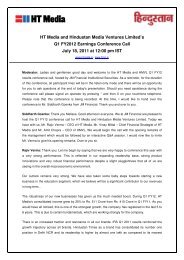Download latest annual report - HT Media
Download latest annual report - HT Media
Download latest annual report - HT Media
Create successful ePaper yourself
Turn your PDF publications into a flip-book with our unique Google optimized e-Paper software.
differences on such contracts are recognized in the<br />
statement of profit and loss in the year in which the<br />
exchange rates change. Any profit or loss arising on<br />
cancellation or renewal of forward exchange contract<br />
is recognized as income or as expense for the year.<br />
Translation of Integral and Non-integral foreign<br />
operation<br />
The financial statements of an integral foreign operation<br />
are translated as if the transactions of the foreign<br />
operation have been those of the company itself.<br />
In translating the financial statements of a nonintegral<br />
foreign operation for incorporation in financial<br />
statements, the assets and liabilities, both monetary<br />
and non-monetary, of the non-integral foreign<br />
operation are translated at the closing rate; income and<br />
expense items of the non-integral foreign operation<br />
are translated at exchange rates at the dates of the<br />
transactions; and all resulting exchange differences are<br />
accumulated in a foreign currency translation reserve<br />
until the disposal of the net investment.<br />
On the disposal of a non-integral foreign operation,<br />
the cumulative amount of the exchange differences<br />
which have been deferred and which relate to that<br />
operation are recognised as income or as expenses in<br />
the same period in which the gain or loss on disposal is<br />
recognised.<br />
When there is a change in the classification of a foreign<br />
operation, the translation procedures applicable to the<br />
revised classification are applied from the date of the<br />
change in the classification.<br />
n) Retirement and other employee benefits<br />
i. Retirement benefits in the form of Provident Fund<br />
and Pension Schemes are defined contribution<br />
schemes and the contributions are charged to<br />
the Profit and Loss account of the year when the<br />
contributions to the respective funds are due. There<br />
are no other obligations other than the contribution<br />
payable to the respective funds.<br />
ii. Gratuity of employees of Parent Company is a<br />
defined benefit plan and provision in respect of it is<br />
made as per actuarial valuation carried out as per<br />
Projected Unit Credit method by an independent<br />
actuary as at year end and is contributed to<br />
Gratuity Fund created by the holding company of<br />
the Parent Company. The liability towards gratuity<br />
of certain employees of a Subsidiary Company is<br />
ascertained based on demand received from Life<br />
Insurance Corporation of India (LIC) with whom a<br />
Group Gratuity Policy has been taken and is paid<br />
to them. LIC has ascertained the gratuity liability<br />
on actuarial valuation basis at the year-end. The<br />
liability in respect of gratuity of employees of<br />
other Subsidiary Companies and Joint Venture<br />
Company is provided as per actuarial valuation as<br />
per projected unit credit method carried out by an<br />
independent actuary (ies) at the year end.<br />
iii. Accumulated leave, which is expected to be utilized<br />
within the next 12 months, is treated as shortterm<br />
employee benefit. The Group measures the<br />
expected cost of such absences as the additional<br />
<strong>HT</strong> <strong>Media</strong> Limited<br />
amount that it expects to pay as a result of the<br />
unused entitlement that has accumulated at the<br />
<strong>report</strong>ing date.<br />
The Group treats accumulated leave expected to<br />
be carried forward beyond twelve months, as longterm<br />
employee benefit for measurement purposes.<br />
Such long-term compensated absences are<br />
o)<br />
provided for based on the actuarial valuation using<br />
the projected unit credit method at the year-end.<br />
Actuarial gains/losses are immediately taken to the<br />
statement of profit and loss and are not deferred.<br />
The Company presents the entire leave as current<br />
liability in the balance sheet, since it does not have<br />
as unconditional right to defer its settlement for 12<br />
months after the <strong>report</strong>ing date.<br />
Provisions<br />
A provision is recognized when the Group has a<br />
present obligation as a result of past event and it is<br />
probable that an outflow of resources will be required<br />
to settle the obligation, in respect of which a reliable<br />
estimate can be made. Provisions are not discounted<br />
to their present value and are determined based on<br />
best estimate required to settle the obligation at each<br />
Balance Sheet date. These are reviewed at each<br />
Balance Sheet date and are adjusted to reflect the<br />
current best estimates.<br />
Provision for expenditure relating to voluntary retirement<br />
is made when the employee accepts the offer of early<br />
retirement and such provision amount is charged to<br />
statement of profit and loss in the year of provision.<br />
p) Income Taxes<br />
Tax expense comprises current and deferred tax.<br />
Current income tax is measured at the amount<br />
expected to be paid to the tax authorities in accordance<br />
with the Income-tax Act, 1961 enacted in India and<br />
tax laws prevailing in the respective tax jurisdictions<br />
where the Group operates. Current income tax relating<br />
to items recognized directly in equity is recognized in<br />
equity and not in the statement of profit and loss.<br />
Deferred Income Tax reflects the impact of timing<br />
differences between taxable income and accounting<br />
income originating during the current year and reversal<br />
of timing differences for the earlier years. Deferred<br />
tax is measured using the tax rates and the tax laws<br />
enacted or substantively enacted at the balance sheet<br />
date. Deferred income tax relating to items recognized<br />
directly in equity is recognized in equity and not in the<br />
statement of profit and loss.<br />
Deferred tax liabilities are recognized for all taxable<br />
timing differences. Deferred tax assets are recognized<br />
for deductible timing differences only to the extent<br />
that there is reasonable certainty that sufficient future<br />
taxable income will be available against which such<br />
deferred tax assets can be realized. In situations<br />
where the Group has unabsorbed depreciation or<br />
carry forward tax losses, all deferred tax assets are<br />
recognized only if there is virtual certainty supported by<br />
convincing evidence that they can be realized against<br />
future taxable profits.<br />
At each balance sheet date the Group re-assesses<br />
105





